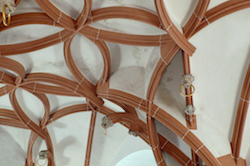New insights into how the great Gothic vaults were constructed helps restorers of the future
When it comes to the fantastically intricate design of Gothic vaulting and ribbed arches, we have had very little knowledge of how architects communicated with master masons. The few sketched-out plans that exist, such as that for a part of the Cathedral of Strasbourg, show a surprising lack of written instruction and even measurements are missing. With the architect in a different place to the building site itself, the question that has baffled researchers in this domain is: how did such complex structures make it from two-dimensional drawing to the great, three dimensional vaults that captivate us today? Finding the answer was the primary goal of the EU-funded REGOTHICVAULTDESIGN (Design Principles in Late-Gothic Vault Construction – A New Approach Based on Surveys, Reverse Geometric Engineering and a Reinterpretation of the Sources) project. As project coordinator Dr David Wendland explains, “Until now our knowledge has been mainly based on sources which, in some aspects, appear incomplete. The innovative approach of the project consists in formulating hypotheses on the design directly from the built artefact, with a working method not common in surveying until now.” Although an interesting conundrum in its own right, the question also feeds into restoration and maintenance: good conservation practice benefits from the ability to draw on original techniques. Exploring techniques of medieval master masons The stonemasons’ knowledge was shared orally, in lodges and workshops. One such workshop, which was involved with the building of Strasbourg Minster from the 12th to 16th century, is still up and running. Historically accurate stonemasonry techniques are taught there today, which made the workshop a logical participant in Dr Wendland’s research. To establish how the master masons of 500 years ago went about their work, and to work out how they instructed the cutters to size the stones with such geometric precision, Dr Wendland and his team reverse engineered, among many others, the ribbed vaulting of St Anne’s church in Annaberg, and the Palace of Meissen, Germany. “These structures are extremely complex in their geometry, with complicated meshes of ribs soaring along three-dimensional curves and intersecting on multiple levels at the keystones,” says Dr Wendland, who was based at the Technical University of Dresden, Germany. One technique the project employed was to create a large expanse of plaster surface (10x15 metres), which was formed into a ‘tracing surface’ at the University of Dresden. Tracing floors were a standard technique used at the time and researchers were keen to replicate the process, using only squares, compasses and rulers. A drawn out process Using the tracing floor and the instruments the original masons would have employed, the team drew out the pattern for the vault at Meissen. “Representing the three dimensional on a flat plane was a real challenge,” Dr Wendland explains. Once the design was mapped out on the plaster, the researchers compared the pattern with the dimensions discovered through their survey of the original vault. Copper templates, referred to in some manuscript descriptions of the task, were used to transfer flat designs to the three dimensional stone carving. “We tested our theory using gas blocks as they are easy to carve and allowed us to carry out rapid trials,” he says. However, their system proved to be robust and the work moved onto quality stone quite quickly. 21st century master masons, 500 year-old know-how Academic research was not the sole aim of the two projects. Of equal importance to the Franco-German team was the dissemination of ‘living knowledge’. To that end, apprentices at the stone masons’ workshop were involved in the carving. As Dr Wendland puts it, “The knowledge of the historical procedure in planning and setting out is now available for anyone working on the restoration of historic vaults. Involving young professionals in this is vital if the information is to be transmitted.” He goes on to explain that the idea behind the whole project is not only to rediscover and understand historical techniques, but to incorporate them into current restoration practices. “Restorers should at least have the option of using historical setting-out, planning and cutting techniques.” Long-term research with even longer-term goals The team’s work was carried out over the lifespan of two EU-supported projects. Building on the processes explored by REGOTHICVAULTDESIGN, which focused on surveying, the second phase, called REGothicVaultElements (Late Gothic vaults and their complex stone members: Recovering historical design procedures, implementing knowledge in restoration practice), concentrated on replicating construction techniques. “These projects have enabled us to gain a deeper understanding of the principles of the geometric design and how the instructions for producing their single stone elements were formulated. These insights will feed into the conservation practices of the future,” says Dr Wendland.
Keywords
REGOTHICVAULTDESIGN, REGothicVaultElements, Gothic architecture, restoration, cathedrals, minsters, ribbed vaults



